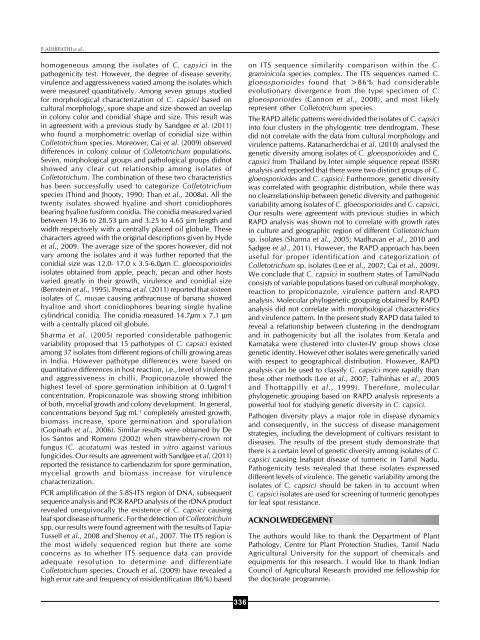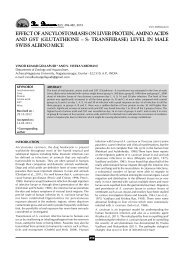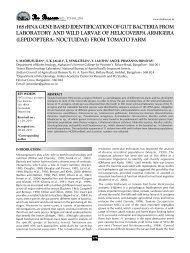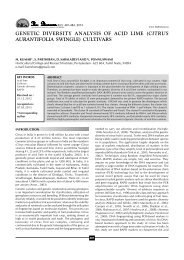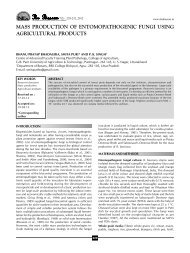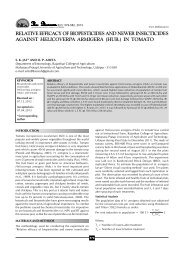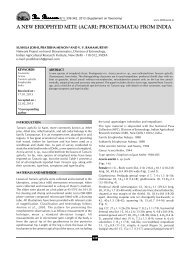Morphological characterization and molecular ... - THE BIOSCAN
Morphological characterization and molecular ... - THE BIOSCAN
Morphological characterization and molecular ... - THE BIOSCAN
- No tags were found...
Create successful ePaper yourself
Turn your PDF publications into a flip-book with our unique Google optimized e-Paper software.
P. ADHIPATHI et al.,homogeneous among the isolates of C. capsici in thepathogenicity test. However, the degree of disease severity,virulence <strong>and</strong> aggressiveness varied among the isolates whichwere measured quantitatively. Among seven groups studiedfor morphological <strong>characterization</strong> of C. capsici based oncultural morphology, spore shape <strong>and</strong> size showed an overlapin colony color <strong>and</strong> conidial shape <strong>and</strong> size. This result wasin agreement with a previous study by S<strong>and</strong>gee et al. (2011)who found a morphometric overlap of conidial size withinColletotrichum species. Moreover, Cai et al. (2009) observeddifferences in colony colour of Colletotrichum populations.Seven, morphological groups <strong>and</strong> pathological groups didnotshowed any clear cut relationship among isolates ofColletotrichum. The combination of these two characteristicshas been successfully used to categorize Colletotrichumspecies (Thind <strong>and</strong> Jhooty, 1990; Than et al., 2008a). All thetwenty isolates showed hyaline <strong>and</strong> short conidiophoresbearing hyaline fusiform conidia. The conidia measured variedbetween 19.36 to 28.53 μm <strong>and</strong> 3.25 to 4.65 μm length <strong>and</strong>width respectively with a centrally placed oil globule. Thesecharacters agreed with the original descriptions given by Hydeet al., 2009. The average size of the spores however, did notvary among the isolates <strong>and</strong> it was further reported that theconidial size was 12.0- 17.0 x 3.5-6.0μm C. gloeosporioidesisolates obtained from apple, peach, pecan <strong>and</strong> other hostsvaried greatly in their growth, virulence <strong>and</strong> conidial size(Bernstein et al., 1995). Prema et al. (2011) reported that sixteenisolates of C. musae causing anthracnose of banana showedhyaline <strong>and</strong> short conidiophores bearing single hyalinecylindrical conidia. The conidia measured 14.7μm x 7.1 μmwith a centrally placed oil globule.Sharma et al. (2005) reported considerable pathogenicvariability proposed that 15 pathotypes of C. capsici existedamong 37 isolates from different regions of chilli growing areasin India. However pathotype differences were based onquantitative differences in host reaction, i.e., level of virulence<strong>and</strong> aggressiveness in chilli. Propiconazole showed thehighest level of spore germination inhibition at 0.1μgml - 1concentration. Propiconazole was showing strong inhibitionof both, mycelial growth <strong>and</strong> colony development. In general,concentrations beyond 5μg mL -1 completely arrested growth,biomass increase, spore germination <strong>and</strong> sporulation(Gopinath et al., 2006). Similar results were obtained by Delos Santos <strong>and</strong> Romero (2002) when strawberry-crown rotfungus (C. acutatum) was tested in vitro against variousfungicides. Our results are agreement with S<strong>and</strong>gee et al. (2011)reported the resistance to carbendazim for spore germination,mycelial growth <strong>and</strong> biomass increase for virulence<strong>characterization</strong>.PCR amplification of the 5.8S-ITS region of DNA, subsequentsequence analysis <strong>and</strong> PCR-RAPD analysis of the rDNA productrevealed unequivocally the existence of C. capsici causingleaf spot disease of turmeric. For the detection of Colletotrichumspp. our results were found agreement with the results of Tapia-Tussell et al., 2008 <strong>and</strong> Shenoy et al., 2007. The ITS region isthe most widely sequenced region but there are someconcerns as to whether ITS sequence data can provideadequate resolution to determine <strong>and</strong> differentiateColletotrichum species. Crouch et al. (2009) have revealed ahigh error rate <strong>and</strong> frequency of misidentification (86%) basedon ITS sequence similarity comparison within the C.graminicola species complex. The ITS sequences named C.gloeosporioides found that >86% had considerableevolutionary divergence from the type specimen of C.gloeosporioides (Cannon et al., 2008), <strong>and</strong> most likelyrepresent other Colletotrichum species.The RAPD allelic patterns were divided the isolates of C. capsiciinto four clusters in the phylogentic tree dendrogram. Thesedid not correlate with the data from cultural morphology <strong>and</strong>virulence patterns. Ratanacherdchai et al. (2010) analysed thegenetic diversity among isolates of C. gloeosporioides <strong>and</strong> C.capsici from Thail<strong>and</strong> by Inter simple sequence repeat (ISSR)analysis <strong>and</strong> reported that there were two distinct groups of C.gloeosporioides <strong>and</strong> C. capsici. Furthermore, genetic diversitywas correlated with geographic distribution, while there wasno clearrelationship between genetic diversity <strong>and</strong> pathogenicvariability among isolates of C. gloeosporioides <strong>and</strong> C. capsici.Our results were agreement with previous studies in whichRAPD analysis was shown not to correlate with growth ratesin culture <strong>and</strong> geographic region of different Colletotrichumsp. isolates (Sharma et al., 2005; Madhavan et al., 2010 <strong>and</strong>Sadgee et al., 2011). However, the RAPD approach has beenuseful for proper identification <strong>and</strong> categorization ofColletotrichum sp. isolates (Lee et al., 2007; Cai et al., 2009).We conclude that C. capsici in southern states of TamilNaduconsists of variable populations based on cultural morphology,reaction to propiconazole, virulence pattern <strong>and</strong> RAPDanalysis. Molecular phylogenetic grouping obtained by RAPDanalysis did not correlate with morphological characteristics<strong>and</strong> virulence pattern. In the present study RAPD data failed toreveal a relationship between clustering in the dendrogram<strong>and</strong> in pathogenicity but all the isolates from Kerala <strong>and</strong>Karnataka were clustered into cluster-IV group shows closegenetic identity. However other isolates were genetically variedwith respect to geographical distribution. However, RAPDanalysis can be used to classify C. capsici more rapidly thanthese other methods (Lee et al., 2007; Talhinhas et al., 2005<strong>and</strong> Thottappilly et al., 1999). Therefore, <strong>molecular</strong>phylogenetic grouping based on RAPD analysis represents apowerful tool for studying genetic diversity in C. capsici.Pathogen diversity plays a major role in disease dynamics<strong>and</strong> consequently, in the success of disease managementstrategies, including the development of cultivars resistant todiseases. The results of the present study demonstrate thatthere is a certain level of genetic diversity among isolates of C.capsici causing leafspot disease of turmeric in Tamil Nadu.Pathogenicity tests revealed that these isolates expresseddifferent levels of virulence. The genetic variability among theisolates of C. capsici should be taken in to account whenC. capsici isolates are used for screening of turmeric genotypesfor leaf spot resistance.ACKNOLWEDEGEMENTThe authors would like to thank the Department of PlantPathology, Centre for Plant Protection Studies, Tamil NaduAgricultural University for the support of chemicals <strong>and</strong>equipments for this research. I would like to thank IndianCouncil of Agricultural Research provided me fellowship forthe doctorate programme.336


